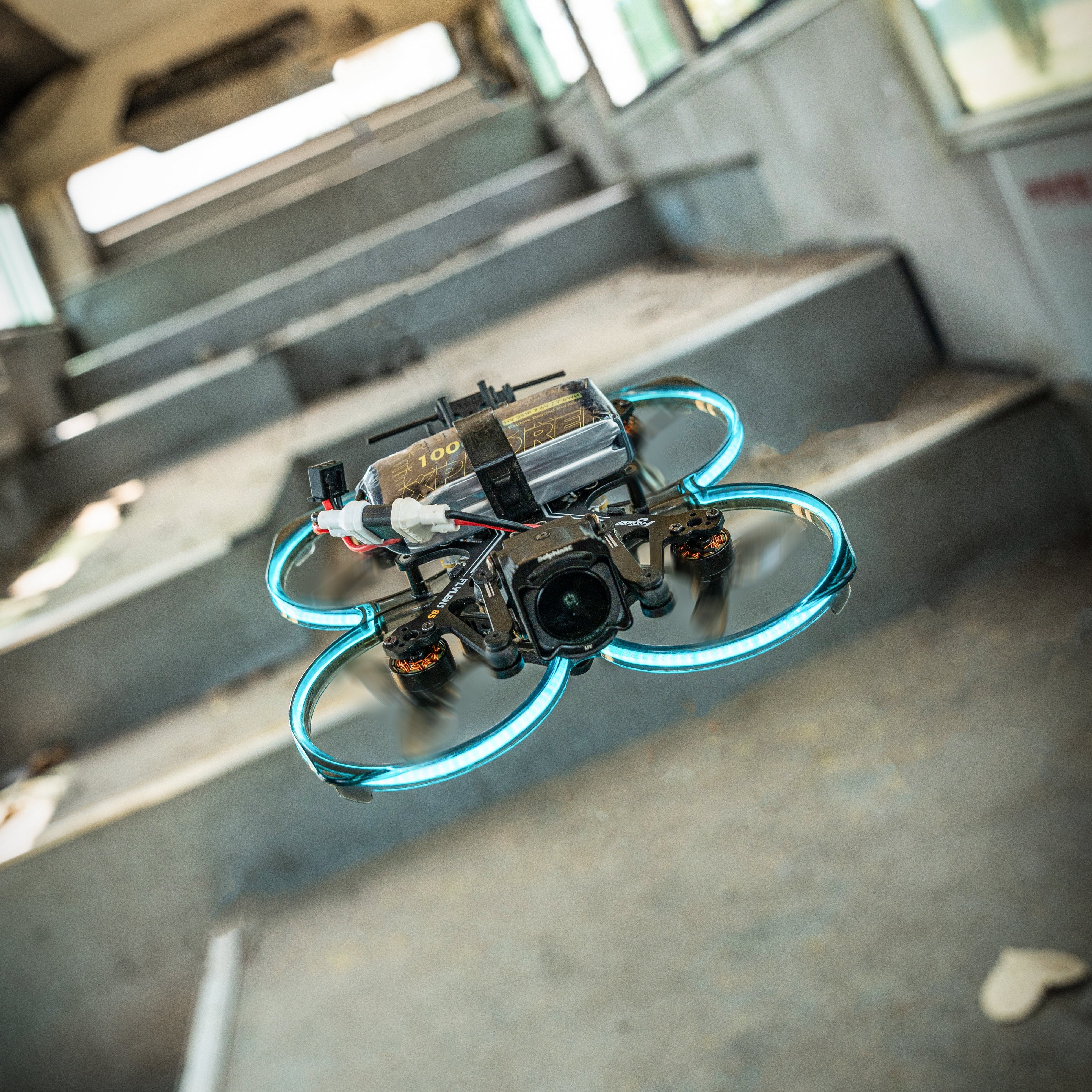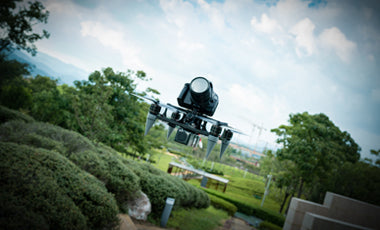The choice of electric drone motors has a great influence on the flight characteristics of the drone. Small differences in motor design have a big impact on multicopper weight, responsiveness, and overall performance.
Before choosing motors, you should at least have a rough idea of the size and weight of the drone you want to build
Some of the most important considerations are:
- Motor weight
- Power (thrust)
- Efficiency (g/watt)
- Torque and response (RPM changes)
Working of a Drone Motor
A key concept behind how both brushed and brushless DC motors work is electromagnetism. Both designs use electromagnets as a means of converting electrical energy into kinetic energy. When an electromagnet is charged, it creates a magnetic field. This temporary magnetic field interacts with the magnetic field of the permanent magnets in the motor. The combination of attractive and repulsive forces of electromagnets or permanent magnets causes the motor shaft to rotate.

Brushed and Brushless Motors:
There are two main types of motors used for drones, Brushless and Brushed motors. Usually, we use brushless motors on bigger models (such as racing drones, cinematography drones), and Brushed on the micro drones and toy drones. This guide will talk more about brushless motors as they are the most widely used motors for drone and multirotor applications.

Brushed Motors:
The inner working of the brushed motor is back to that of the brushless drone motor. In brush motors, the stator provides a permanent magnetic field that surrounds the rotor. The brush motor rotor is an electromagnet influenced by the surrounding stator. A pair of brushes connected to a DC source contacts the commutator at the rotor base. The collector ring is separated, so its rotation will periodically reverse the direction of current flowing through the rotor, because its rotation causes the collector to reverse its polarity. The alternation of the collector ring poles results in an uninterrupted rotation of the rotor. The system efficiency is greatly reduced due to the increase In thermal insulation of the internal mechanics it is also possible to reverse the rotation direction of the motor by inverting the polarity of the DC power input.
Brushless Motors:
As the name suggests, brushless drone motors lack brushes. Brushless motors can effectively be divided into two separate components: rotor and stator. The stator is the central part to which the rotor is mounted. The stator is made up of an array of radial electromagnets that alternately turn on and off to create a temporary magnetic field when current flows through the windings. The rotor contains a collection of permanent magnets placed near the stator's semi-permanent electromagnets. Although the brushless motor is DC powered, it cannot be driven directly. Instead, the brushless motor is hard-wired to the control electronics, effectively eliminating the need for a brush or commutator. The life of the brushless motor is excellent because there is no physical contact between the rotor and the stator
Motor Sizing and Identification
The size of a brushless motor is defined by a four-digit code detailing the size of the stator in millimeters, for example:2206
The first two digits of the series define the diameter of the stator, in this case 22 mm. The last two digits describe the height of the stator, the last two in this series are "06" so the stator unit is 6mm high.
The size of the brush motor can be determined through a simpler two-digit system that clearly defines the diameter and height of the outer box in millimeters. Example:
6×15, the first number "6" is the measurement of the diameter of the can and "15" is the height of the can.
Mounting Patterns and Thread Size
Mounting type and thread size depend on motor type and application. The mounting type determines the location of the threaded bolt holes on the motor base. Each number describes the diameter of a circle whose center is centered on the motor shaft. Usually, four holes are placed along the circumference of the circle, if given two numbers, two holes are placed on each circle. For example, a 2205 with a 16×19 pitch will have 4 M3 size threaded holes evenly distributed around the circumference of a 16mm circle and a 19mm circle. Threaded shaft dimensions are provided by the ISO thread index, which describes the outside diameter of the shaft.
220X-240X:
16x19mm is the most used mounting pattern, however, 16×16 is becoming increasingly common. The thread holes are size M3. The thread shaft diameter D = M5.

Thrust to Weight Ratio
Thrust is one of the main factors to consider when choosing a motor. Thrust of a motor is usually measured in grams and varies depending on how fast the motor and the propeller is rotating. Before a multicopter can begin to accelerate, a thrust is required to overcome drag, as well as gravity.
For example, if the total weight of your drone is 1 kg, the total thrust produced by the motor at 100% throttle should be 2 kg or 500 g per motor for a quadcopter and for racing drones, the thrust/weight ratio is much more than normal multi-rotor. For racing drones, the recommended thrust-to-weight ratio is 5:1
If your quad draws a lot of current at high throttle, the maximum discharge rate of your battery must be able to keep up. The battery must also have the capacity to provide the maximum flight time and power all the components simultaneously.
KV Ratings:
The speed constant (kV) determines the number of revolutions the motor can make in one minute of no load (no propeller) and at a constant current of 1 Volt. Simply, kV is a representation of the rotational speed of the motor. The kV of the motor is determined by the magnetic field strength at the stator and the number of turns in the coil. Motors with lower kV are best suited for efficient drive of heavy-duty propellers. High kV motor optimized for light propellers.
For example, if you choose a 1000KV motor and use a 12V lipo battery for power, the total RPM will be 1000*12=12000 After installing the propeller in the motor, the rpm decreases due to the resistance of the air. The higher KV motor rotates the propeller faster and can draw more current. Therefore, we tend to see larger rotors used with low KV motors, while smaller, lighter blades are better suited to high KV motors. If we combine larger propeller with high KV motor, more torque will be required to spin faster. While generating the required torque, it will draw more current and generate too much heat. This overheating can also damage your motor.
Efficiency and Current Draw:
Motor efficiency is usually calculated by dividing thrust by power at 100% throttle, measured in grams per watt (g/w). The higher this number, the more efficient the motor.
It is important to consider efficiency across the entire throttle range, not just at the top end. Some motors can operate efficiently at low rpm but can lose efficiency by pulling currents higher and higher as they reach their limit.
Another good way to gauge efficiency is to use "grams per amp" (gain/current). In general, the greater the thrust generated, the greater the current consumed to produce that thrust, so motors with high thrust and low current are preferred. Inefficient motors generate too little thrust or draw too much current. Each responds differently to different propellers, choosing your propellers carefully is key to balancing thrust and efficiency. Efficiency and current affect your battery choice. An efficient motor with large currents can overuse your battery and cause power outages.
Selection Guide Table:

Advanced Motor Selection:
Most quadcopter motor specifications are not mentioned by the manufacturers and can only be found through more testing and analysis.
- Torque
- Load
- Response Time
- Propeller size and Prop balancing
- Temperature
- Vibration and balance
- Motor Movements
- Motor Build material





Leave a comment